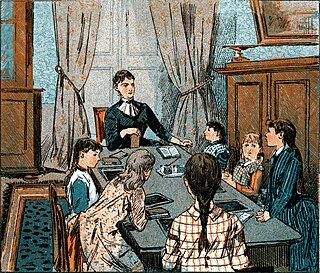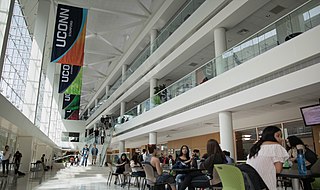
The Family Educational Rights and Privacy Act of 1974 is a United States federal law that governs the access to educational information and records by public entities such as potential employers, publicly funded educational institutions, and foreign governments. The act is also referred to as the Buckley Amendment, for one of its proponents, Senator James L. Buckley of New York.

Homeschooling or home schooling, also known as home education or elective home education (EHE), is the education of school-aged children at home or a variety of places other than a school. Usually conducted by a parent, tutor, or online teacher, many homeschool families use less formal, more personalized and individualized methods of learning that are not always found in schools. The actual practice of homeschooling varies considerably. The spectrum ranges from highly structured forms based on traditional school lessons to more open, free forms such as unschooling, which is a lesson- and curriculum-free implementation of homeschooling. Some families who initially attended a school go through a deschool phase to break away from school habits and prepare for homeschooling. While "homeschooling" is the term commonly used in North America, "home education" is primarily used in Europe and many Commonwealth countries. Homeschooling should not be confused with distance education, which generally refers to the arrangement where the student is educated by and conforms to the requirements of an online school, rather than being educated independently and unrestrictedly by their parents or by themselves.

In the United States, education is provided in public and private schools and by individuals through homeschooling. State governments set overall educational standards, often mandate standardized tests for K–12 public school systems and supervise, usually through a board of regents, state colleges, and universities. The bulk of the $1.3 trillion in funding comes from state and local governments, with federal funding accounting for about $260 billion in 2021 compared to around $200 billion in past years.

Charter schools in the United States are primary or secondary education institutions that are public schools which are publicly funded and operate independently, rather than being overseen by local school districts. Charter schools have a contract with local school districts or other authorizing bodies that allow them to operate. These contracts, or charters, are how charter schools bear their name. They are funded with public tax dollars, though they also fundraise independently. Charter schools are subject to fewer rules than traditional state schools in exchange for greater accountability. Proponents argue that they are meant to serve underserved communities that wish to have alternatives to their neighborhood school. Charters are run as either non-profit or for-profit institutions. However, there are some for-profit management organizations that hold charters, though these are only allowed in Arizona. Only non-profit charters can receive donations from private sources, just the same as traditional public schools.

In the U.S. education system, magnet schools are public schools with specialized courses or curricula. Normally, a student will attend an elementary school, and this also determines the middle school and high school they attend unless they move. "Magnet" refers to how magnet schools accept students from different areas, pulling students out of the normal progression of schools. Attending them is voluntary.

School discipline relates to actions taken by teachers or school organizations toward students when their behavior disrupts the ongoing educational activity or breaks a rule created by the school. Discipline can guide the children's behavior or set limits to help them learn to take better care of themselves, other people and the world around them.
Zelman v. Simmons-Harris, 536 U.S. 639 (2002), was a 5–4 decision of the United States Supreme Court that upheld an Ohio program that used school vouchers. The Court decided that the program did not violate the Establishment Clause of the First Amendment, as long as parents using the program were allowed to choose among a range of secular and religious schools.
An Individualized Education Program (IEP) is a legal document under United States law that is developed for each public school child in the U.S. who needs special education. It is created through a team of the child's parent(s) and district personnel who are knowledgeable about the child's needs. IEPs must be reviewed every year to keep track of the child's educational progress.

A Hauptschule is a secondary school in Germany, starting after four years of elementary schooling (Grundschule), which offers Lower Secondary Education according to the International Standard Classification of Education. Any student who attends a German elementary school can go to a Hauptschule or Gesamtschule, while students who want to attend a Realschule or Gymnasium need to have good marks in order to do so. The students spend five to six years at the Hauptschule, from 5th to 9th grade. They finish around age 15 to 17.

The New York City Department of Education (NYCDOE) is the department of the government of New York City that manages the city's public school system. The City School District of the City of New York is the largest school system in the United States, with over 1.1 million students taught in more than 1,800 separate schools. The department covers all five boroughs of New York City, and has an annual budget of around $38 billion.
Dropping out refers to leaving high school, college, university or another group for practical reasons, necessities, inability, apathy, or disillusionment with the system from which the individual in question leaves.
Waterbury Public Schools is a school district based in Waterbury, Connecticut.

The educational attainment of the U.S. population refers to the highest level of education completed. The educational attainment of the U.S. population is similar to that of many other industrialized countries with the vast majority of the population having completed secondary education and a rising number of college graduates that outnumber high school dropouts. As a whole, the population of the United States is spending more years in formal educational programs. As with income, levels differ by race, age, household configuration, and geography.

Education in Stamford, Connecticut takes place in both public and private schools and college and university campuses. Stamford has a highly educated population. Per the American Community Survey from 2017 to 2021, 89.1% of adults aged 25 and older graduated from high school, and 52.3% have a Bachelor's degree or higher. This compares to 91.1% and 37.9% nationally, respectively.
Educational inequality is the unequal distribution of academic resources, including but not limited to school funding, qualified and experienced teachers, books, and technologies, to socially excluded communities. These communities tend to be historically disadvantaged and oppressed. Individuals belonging to these marginalized groups are often denied access to schools with adequate resources. Inequality leads to major differences in the educational success or efficiency of these individuals and ultimately suppresses social and economic mobility. Inequality in education is broken down into different types: regional inequality, inequality by sex, inequality by social stratification, inequality by parental income, inequality by parent occupation, and many more.

Norwalk Public Schools is the school district serving Norwalk, Connecticut.
The racial achievement gap in the United States refers to disparities in educational achievement between differing ethnic/racial groups. It manifests itself in a variety of ways: African-American and Hispanic students are more likely to earn lower grades, score lower on standardized tests, drop out of high school, and they are less likely to enter and complete college than whites, while whites score lower than Asian Americans.

High school or senior high school is the education students receive in the final stage of secondary education in the United States. In the United States most high schoolers are ages 13-18 but some ages could be delayed due to birthdays. Most comparable to secondary schools, high schools generally deliver phase three of the ISCED model of education. High schools have subject-based classes. The name high school is applied in other countries, but no universal generalization can be made as to the age range, financial status, or ability level of the pupils accepted. In North America, most high schools include grades 9 through 12. Students attend them following graduation from middle school.
There was a resurgence of homeschooling during the COVID-19 pandemic to help students return to school. Innovative parents sought to create solutions to their individual dilemmas by organizing local groups. These variations of homeschooling include micro schools and educational family co-ops. The first usually involves hired professionals to teach a small group of kids. The second is a parent-organized co-operative where families take turns educating and minding their kids during the week. Both are largely available only to the well-off, as costs in time and money are high. 'Pandemic pod' is the fashionable term used to describe one of these arrangements where all group members agree to participate under well-defined and strictly enforced health rules.

In 2020, school systems in the United States began to close down in March because of the spread of COVID-19. This was a historic event in the history of the United States schooling system because it forced schools to shut-down. At the very peak of school closures, COVID-19 affected 55.1 million students in 124,000 public and private U.S. schools. The effects of widespread school shut-downs were felt nationwide, and aggravated several social inequalities in gender, technology, educational achievement, and mental health.












